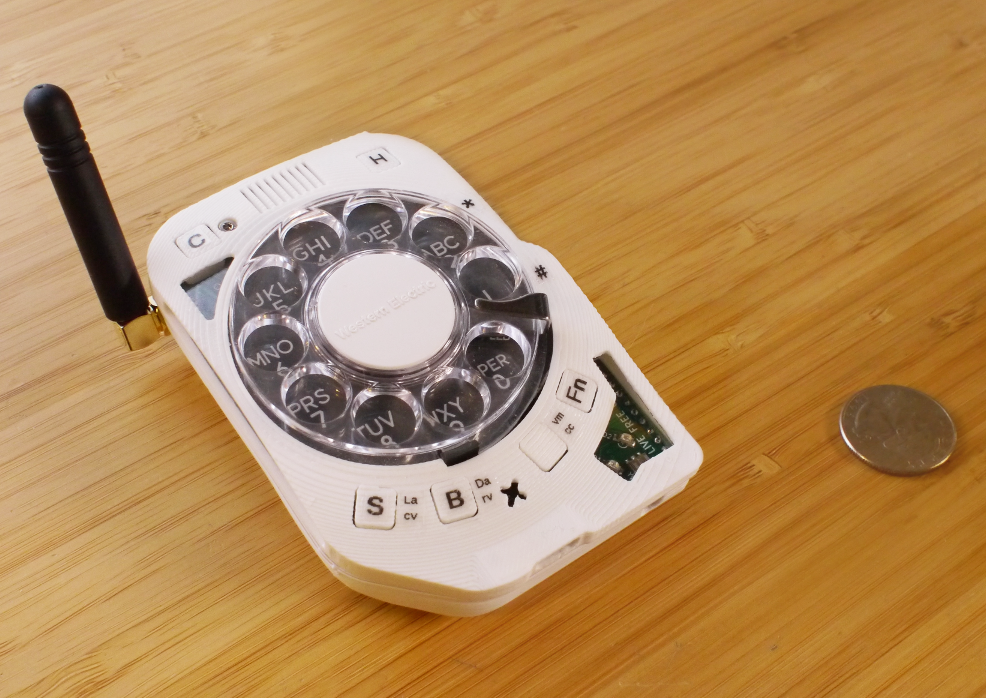Rotary Cellphone Kit
Open Source Portable Wireless Electronic Digital Rotary
Telephone
I've been getting so many requests from people wanting to buy
the rotary cellphone described here
that I've decided to make it available in a minimal kit form.
Builders will still need to find the right rotary dial and order
a handful of other bits, shown below, but the "hard part" (the
mainboard and the 3D printed casing with threaded inserts and
buttons shown above) is available for sale here. A "mark 2"
version of this phone is in the works. This will run on the 4G
cell network and be available as a complete kit.
Expected release: September 2020.
Includes only what's shown above:
ATmega2560v-based Cellphone mainboard
3D printed enclosure and buttons (choice of two colors)
Documentation:
Build instructions: The primary
assembly guide for this kit.
Video: A
supplement in case nuances were missed in the build
instructions.
Forum: Post quesions here for public
discussion with the community.
Open Source Design Files:
Firmware:
Maintained on GitHub.
Kicad Files: The
electrical design.
STLs: The 3D printed
enclosure and buttons.
License: Read before forking.
SOLD OUT
STAY TUNED FOR THE 4G VERSION
READ BEFORE BUYING
This is a DIY project:
Some soldering is still required, as two of the Afafruit components come
with the headers disassembled, and both of them have special notes
detailed in the build instructions. Most oddly, the header for the FONA
3G needs to be soldered on at an angle and the black backing strip needs
to be removed. This is actually pretty easy, and the trick is described
in the build notes.
The builder must supply the following components:
-A Western Electric model 10A rotary dial, described here
and available in certain Trimline rotary telephones.
-Adafruit FONA 3G
(American version) or FONA
3G (European version)
-Adafruit eInk Breakout Friend here
-The Good Display GDEW0213I5F 2.13" flexible ePaper display, which
Adafruit sells here
-1.2Ah Lipo Battery w/ JST connector, available from Adafruit here
-Quad-band GSM Antenna w/ SMA connector, which Adafruit has here
-SMA Bulkhead Connector w/µFL pigtail, which Adafruit has here
-A compatible 3G SIM card. In the US, this
one from AT&T works
Important notes on expectations, features, and quirks:
Builders must bear in mind that I never intended this phone to be
something other people would use. There are certain quirks that I'm
well aware of from an engineering perspective but which might cause
significant trouble for an unknowing end-user, and these issues are
summarized here. If you can live with these, than by all means click
the "buy" button:
This is a 3G phone and in the US, AT&T plans to shut down their
3G network in 2022. I'm working in a 4G version, POSSIBLY with a
backwards compatible upgrade module for this kit.
Currently, battery and signal strength metering is not working. I
hope to have this fixed in firmware soon, but this further complicates
the above quirk. If you have a voltmeter, it's easy to probe battery
voltage without opening the case via the ICSP header on the back
Currently, incomming call identification is not working. I hope to
have this fixed in the firmware soon.
There's an odd bug right now where I can only set call volume or
ring volume once after powering the phone on. This is probably a silly
mistake in the firmware and I should have it fixed soon.
Another annoying thing is that it's stuck with a single ringtone.
Again, I hope to have a fix worked out in firmware at some point.
Your contacts list must be coded directly into the Arduino sketch
The ePaper display isn't installed/bonded just right, it's likely to
develop display artifacts. In fact some artifacting is likely even in
the best case
An in-system programmer is required to upload Arduino sketches, as I
didn't include a reset line from the UART pins. But I feel this is
actually easier to use than a regular USB cable because if the board
isn't totally dead it always just works. I use an Olimex brand
AVR-ISP-MK2, available from Digi-Key for about $20.
Sky's Edge is a subsidiary of Lightsmith Scientific LLC. Wait, why?
Because when I first decided to start a company I decided on the name
Lightsmith Scientific and formed it as an LLC. A few years later I thought
of Sky's Edge, which comes from the
Revelation
Space universe by Alastair Reynolds, and liked it much better.
So on paper Lightsmith Scientific has a "DBA" in NY state for doing
business as Sky's Edge. Also, if someone who knows business could let me
know if it's right to use the word "subsidiary" in this context, I'd
appreciate an email. ~Justine Haupt
